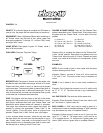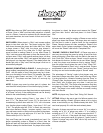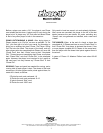
2
INSTRUCTIONS
3
INSTRUCTIONS
NOTE: More than one “Wild” card may be used in completing
a Phase. Once a “Wild” card has been played as a certain
card in a Phase, it cannot be replaced by the intended card
and used elsewhere, but must remain as that card until the
hand is over.
SKIP CARDS: When played, a “Skip” card causes another
player to lose their next turn. The player laying the “Skip”
card down chooses the player who loses their turn. When
a player draws a “Skip” card, the player may discard it
immediately or save it for a later turn. A “Skip” card may
never be used in making Phase 8, or any other Phase. A
“Skip” card may never be picked up from the discard pile. If
a player uses a “Skip” card against another player, no other
player can use another “Skip” card against that player until
that player’s turn has been skipped. If the dealer starts the
discard pile with a “Skip” card, the rst player’s rst turn is
automatically skipped.
MAKING (COMPLETING) A PHASE: If, during the turn, a
player makes (completes) the phase on their active “Phase
Card” with the cards in hand, the player may lay it down,
face up on the table in front of them. For example, the player
is trying to make Phase1 and has 3 “5’s” and 2 “7’s”, and
draws a “7”. The player now has 2 sets of 3 and may lay
them down.
NOTE: A player may never lay down part of a phase, but
must have the whole phase in hand before laying it down.
A player may lay down more than the minimum requirements
of a Phase, but only if the additional cards can be directly
added to the cards already in the Phase.
Examples: A player making Phase 1 lays down 3 “5’s”
and 3 “7’s”. The player has 2 more “5’s” in hand and can
immediately lay them down with the 3 “5’s”, all in the same
turn. Another player making Phase 1 lays down 3 “6’s” and
3 “8’s”. The players also has 3”10’s” in hand, but cannot lay
them down because Phase 1 requires exactly 2 sets. You
may add more cards to a Set but not more Sets to the phase.
Thus, the player can only add more “6’s” and “8’s” to their
Phase made up of “6’s” and “8’s”.
Only one Phase can be made (completed) per hand. If a
player successfully makes a Phase in a hand, then the
player will wait until that hand is nished before choosing a
Phase to attempt for the Next hand. If a player fails to make
the phase in a hand, the player must remove the “Phase”
card from their “Active” area and place it in their “Phase
Pile”.
A player receives credit for making a Phase as soon as the
player lays down that Phase. The player does not need to
win the hand in order to receive credit for the completed
Phase. Several players will often complete a Phase in the
same hand. Once a player completes a Phase, the player
will move the “Phase” card to their “Completed Pile”.
“SAVING” CARDS & “SAVE PILE”: A Player may save a
card any time during the game by taking a card from their
hand and placing it face down onto the table in the area for
their “Save Pile”. When a player “Saves” a card it counts as
their discard for that turn, so their turn is over. When “Saving”
a card, the player must announce this by saying “SAVE”,
then the player should place the card in their “Save Pile”.
Players are allowed to “Save” only 1 card per hand. Players
are allowed to look at their own “Saved” cards at any time
but they can not look at another player’s “Saved” cards.
The advantage of “Saving” cards is that players may use
them later. A player may use a “Save” card in this way: When
it is the players turn, instead of drawing from the “Draw” or
“Discard” piles, the player draws 1 card of their choice from
their “Save” pile. A player may only draw 1 card per turn
from their “Save Pile”. The Player must announce that they
are drawing a “Saved” card by saying, “I’m drawing a Saved
card”. The player’s turn would continue as normal, ending
with their discard.
NOTE: No player may “Save” their “Going Out” discard.
HITTING: Hitting is the way to get rid of leftover cards in the
hand after making a Phase. A player makes a hit by laying
down a card directly on any Phase already laid down. The
card must properly t in with the cards already down.
Example: A player may add one or more “4’s” to a player’s
existing set of “4’s”. A player may add a “2” to a player’s
existing run of “3”, “4”, “5”, “6” - the player may also add a “7”,
and an “8” to this run, if the player has them. A player may
add one or more green cards to a player’s 7 green cards in
Phase 8. A player may add a “Wild” card of any color to any
of these examples.





